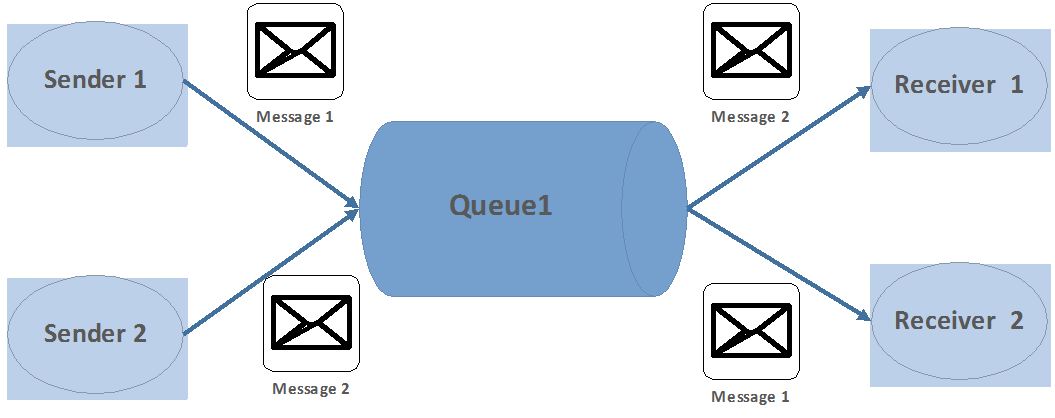This section focuses on the point-to-point (PTP) messaging model. In a PTP messaging model, message producers are called senders and consumers are called receivers. They exchange messages by means of a destination called a queue. Senders produce messages to a queue and receivers consume messages from this queue. What distinguishes point-to-point messaging is that a message can be consumed by only one consumer.
Point-to-point messaging is generally used when a single message will be received by only one message consumer. There may be multiple consumers listening on the queue for the same message but only one of the consumers will receive it. Note that there can be multiple producers as well. They will be sending messages to the queue but it will be received by only one receiver.
Typically, in the PTP model, a receiver requests a message that a sender sends to the queue, rather than subscribing to a channel and receiving all messages sent on a particular queue.
You can think of queues supporting PTP messaging models as FIFO queues. In such queues, messages are sorted in the order in which they were received, and as they are consumed, they are removed from the head of the queue. Queues such as Kafka maintain message offsets. Instead of deleting the messages, they increment the offsets for the receiver. Offset-based models provide better support for replaying messages.
The following figure shows an example model of PTP. Suppose there are two senders, S1 and S2, who send a message to a queue, Q1. On the other side, there are two receivers, R1 and R2, who receive a message from Q1. In this case, R1 will consume the message from S2 and R2 will consume the message from S1:

You can deduce the following important points about a PTP messaging system from the preceding figure:
- More than one sender can produce and send messages to a queue. Senders can share a connection or use different connections, but they can all access the same queue.
- More than one receiver can consume messages from a queue, but each message can be consumed by only one receiver. Thus, Message 1, Message 2, and Message 3 are consumed by different receivers. (This is a message queue extension.)
- Receivers can share a connection or use different connections, but they can all access the same queue. (This is a message queue extension.)
- Senders and receivers have no timing dependencies; the receiver can consume a message whether or not it was running when the sender produced and sent the message.
- Messages are placed in a queue in the order they are produced, but the order in which they are consumed depends on factors such as message expiration date, message priority, whether a selector is used in consuming messages, and the relative message processing rate of the consumers.
- Senders and receivers can be added and deleted dynamically at runtime, thus allowing the messaging system to expand or contract as needed.
The PTP messaging model can be further categorized into two types:
- Fire-and-forget model
- Request/reply model
In fire-and-forget processing, the producer sends a message to a centralized queue and does not wait for any acknowledgment immediately. It can be used in a scenario where you want to trigger an action or send a signal to the receiver to trigger some action that does not require a response. For example, you may want to use this method to send a message to a logging system, to alert a system to generate a report, or trigger an action to some other system. The following figure represents a fire-and-forget PTP messaging model:

With an asynchronous request/reply PTP model, the message sender sends a message on one queue and then does a blocking wait on a reply queue waiting for the response from the receiver. The request/reply model provides for a high degree of decoupling between the sender and receiver, allowing the message producer and consumer components to be heterogeneous languages or platforms. The following figure represents a request/reply PTP messaging model:

Before concluding this section, it is important for you to understand where you can use the PTP model of messaging. It is used when you want one receiver to process any given message once and only once. This is perhaps the most critical difference: only one consumer will process a given message.
Another use case for point-to-point messaging is when you need synchronous communication between components that are written in different technology platforms or programming languages. For example, you may have an application written in a language, say PHP, which may want to communicate with a Twitter application written in Java to process tweets for analysis. In this scenario, a point-to-point messaging system helps provide interoperability between these cross-platform applications.



